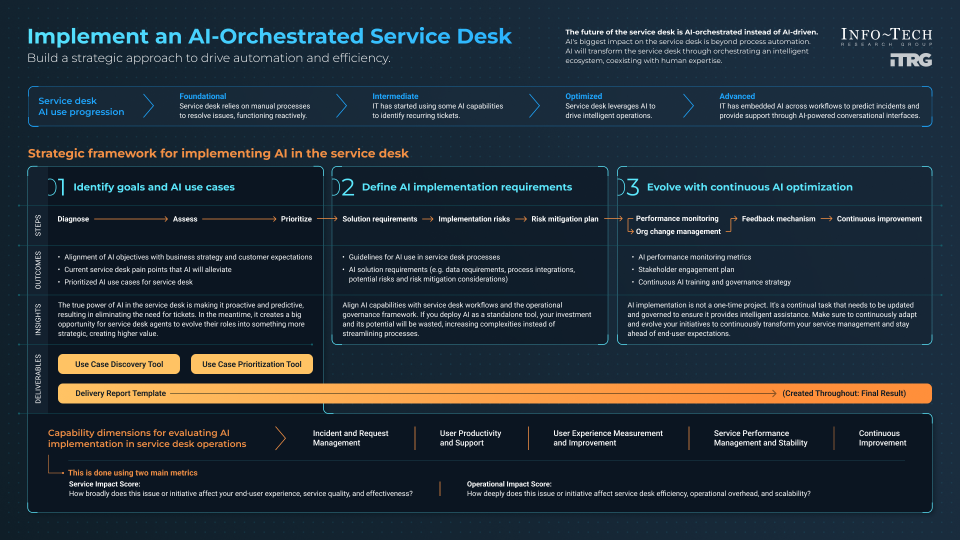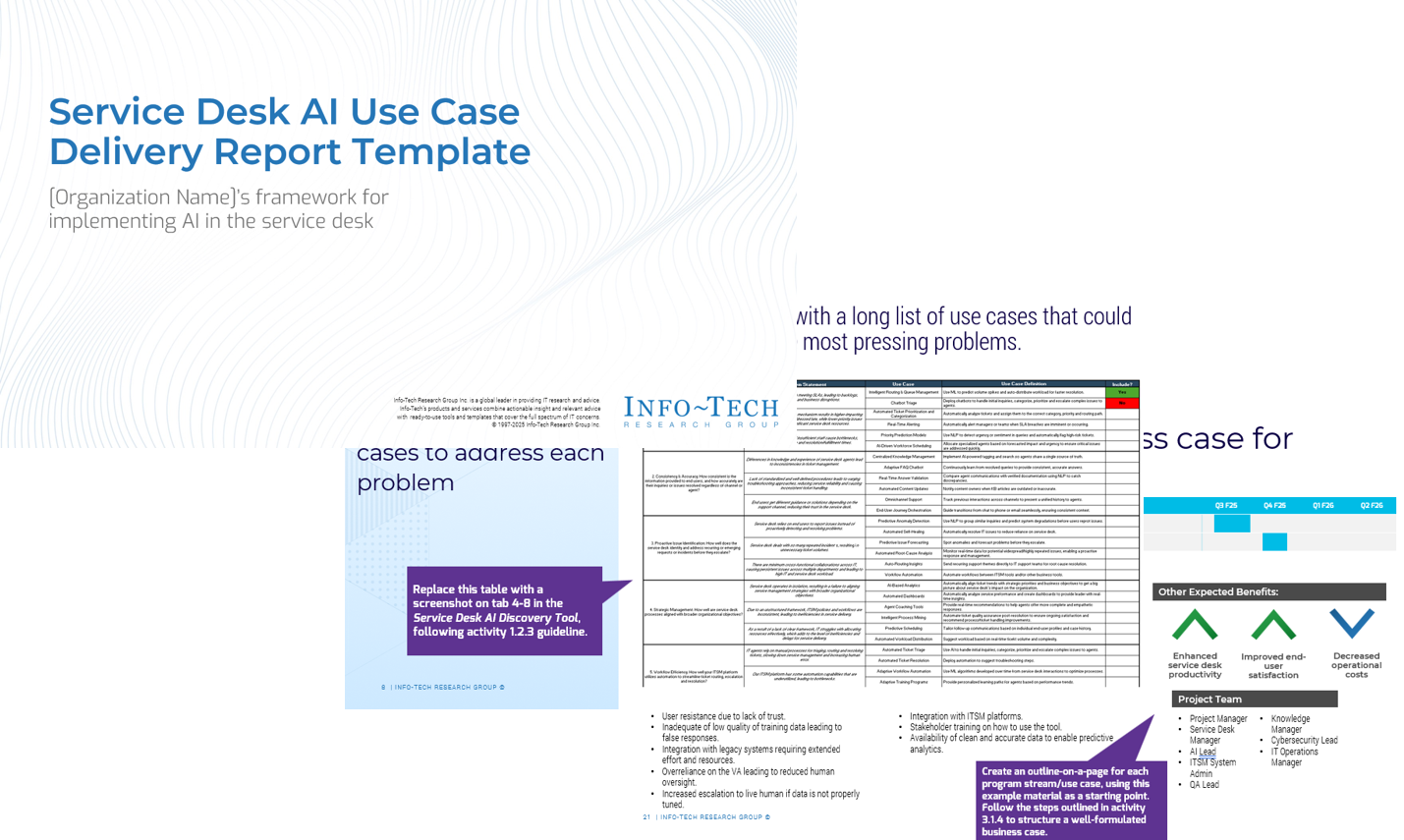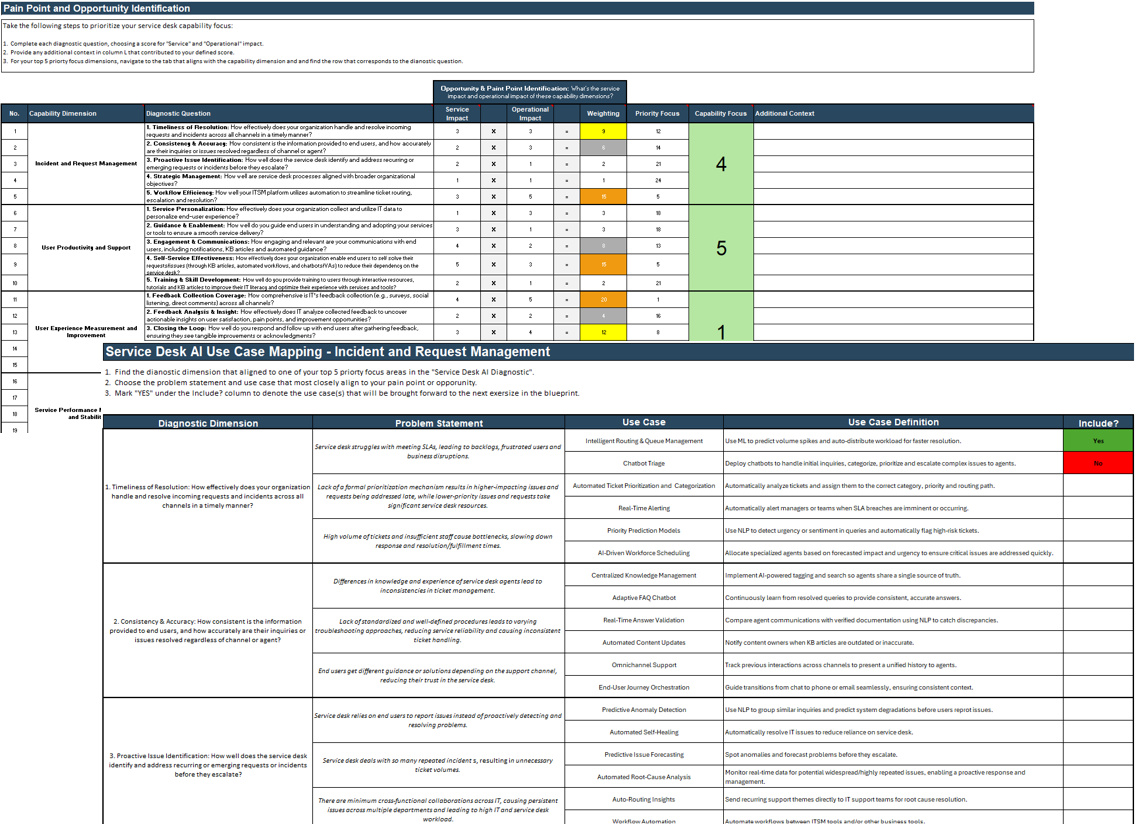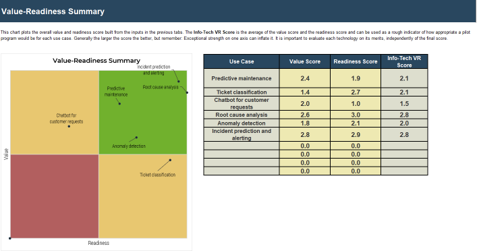The disruptive potential of AI in ITSM offers much more than simply automating the service desk for efficiency gains. The true power of AI lies in its ability to orchestrate an intelligent ecosystem, coexisting with human expertise, to transform user experience and build organizational resilience. Shift your service desk vision from AI-driven to AI-orchestrated with a step-by-step framework that will help you identify and implement AI use cases to transform your service desk.
AI’s unlimited potential is driving organizational demand for a more effective service desk to not only reduce tickets but also power seamless service delivery and predictive solutions. However, many obstacles stand in the way, from legacy systems and skills gaps to transparency concerns and the need for stakeholder buy-in. Overcome these barriers to help IT align AI initiatives with organizational priorities and governance best practices and enable a paradigm shift in your service desk.
1. Reduce incoming tickets to improve outgoing support.
Gear your AI goals toward ticket reduction rather than faster ticket handling. AI must be implemented on the foundation of a proactive IT ecosystem, where issues are predicted and resolved before they impact end users. Ticket reduction will create an opportunity for agents to work on higher-value tasks, providing more impactful results to the organization.
2. 91��Ƭ�� AI synchronicity with the ITSM ecosystem.
Align AI capabilities with your service desk workflows and operational governance framework. Deploying AI as a standalone tool will increase complexities instead of streamlining processes, wasting your investment and its potential.
3. Stay focused on the big picture, even as it changes.
AI implementation is never a one-time project – it’s a continual task that needs to be updated and governed to ensure it provides intelligent assistance. Adapt and evolve your initiatives to continuously transform your service management and stay ahead of end user expectations.
Use our comprehensive blueprint to identify and implement effective AI-based use cases for your service desk
This research will help you to explore how to transform your service desk with AI. Use this step-by-step framework, featuring practical tools and templates, to:
- Assess your objectives for adopting AI for the service desk.
- Implement AI use cases that will help you to transform your service desk practice.
- Continuously drive improvements with AI, extend its capabilities to other areas of IT support, and remain agile in a rapidly evolving IT landscape.
Implement an AI-Orchestrated Service Desk
91��Ƭ�� a strategic approach to drive automation and efficiency.
Implement an AI-Orchestrated Service Desk
91��Ƭ�� a strategic approach to drive automation and efficiency.
EXECUTIVE BRIEF
Analyst perspective
Unleash the power of AI to enable a paradigm shift in your service desk.
Artificial intelligence in IT service management is usually considered an automation engine that helps gain efficiency. Although these benefits have been tangible and significantly helped IT teams, they don’t capture the full disruptive potential of AI in service management. Despite the promising impacts of AI, the service desk may have multiple challenges with implementation, such as data fragmentation, agent concerns, and AI governance. Addressing these concerns can help ensure IT teams align their AI initiatives with organizational priorities and governance best practices.
Although AI can help the service desk reduce costs through staff optimization and a decrease in ticket volume, this perspective is short-sighted. The true power of AI in the service desk lies in building organizational resilience and transforming the user experience, positioning ITSM beyond saving costs.
This research is designed to help you identify AI-based use cases and create an implementation plan to use AI capabilities effectively.

Mahmoud Ramin
Senior 91��Ƭ�� Analyst, AI 91��Ƭ��
91��Ƭ��
Executive summary
Your Challenge
Given the various potential uses of AI, organizations are demanding a more effective service desk to not only reduce tickets but also drive seamless service delivery and predictive solutions. However, they face the following challenges to drive such capabilities:
- Lack of a clear AI governance and implementation framework leads to concerns about risks following implementation.
- Service desk is already firefighting due to current issues, making AI adoption challenging.
- IT does not have a clear understanding about AI use cases for the service desk.
Common Obstacles
AI is hailed as a transformative solution, but many organizations struggle to use its capabilities due to the following obstacles:
- ITSM environments are fragmented and outdated, resulting in low data quality and integration issues.
- Organizations are concerned about AI hallucination and inaccurate responses.
- AI requires significant investment, training, and infrastructure updates, which are a financial burden.
- Service desk has difficulty getting leadership and other stakeholder buy-in for AI use cases due to lack transparency and job security concerns.
Info-Tech’s Approach
This research will help you:
- Assess your objectives for adopting AI for the service desk.
- Implement AI use cases that will help you transform your service desk practice.
- Continuously drive improvements with AI, extend its capabilities to other areas of IT support, and stay agile in a rapidly evolving IT landscape.
At the end of this research, you will walk away with a delivery report that will help you communicate your AI implementation plan for the service desk and your strategy to get ready for other AI-powered use cases.
The future of the service desk is AI-orchestrated instead of AI-driven
AI’s biggest impact on the service desk goes beyond process automation. AI will transform the service desk by orchestrating an intelligent ecosystem, coexisting with human expertise.
Common barriers to AI-enabled transformation
AI implementation presents several common challenges that organizations should navigate.
57% — Lack of Skills
57% of organizations believe they have a shortage of internal expertise to implement AI solutions. (ITSM.tools, 2023)
43% — Legacy Systems
43% of organizations have challenges with outdated and legacy applications, making AI adoption difficult. (ITSM.tools, 2023)
62% — Employee Resistance
62% of managers have reported that their employees are concerned that AI will replace their jobs. (The HR Director, 2024)
55% — Data Security Concerns
55% of data leaders are concerned about exposure of sensitive data by large language models (LLMs). (Immuta, 2024)
Key business challenges of implementing AI for the service desk
High Costs
AI deployment requires significant upfront and maintenance investments.Integration Challenges
Data synchronization is pivotal to ensure ML algorithms are accurate, making it complex for teams using legacy systems.Security Concerns
Data privacy is a big concern, especially for those organizations processing highly confidential data.Lack of Human Touch
Despite its huge capabilities, AI may struggle with handling complex issues that require human judgment.Trust Issues
Service desk agents may fear job displacement due to AI automation, leading to their resistance.Transparency Concerns
AI can potentially act like a “black box,” leading to concerns about lack of process understanding.Scalability Challenges
Scaling AI to drive continuous improvement and customizing use cases to specific organizational requirements can be difficult.ROI Measurement Difficulties
It is challenging to demonstrate a clear return on AI investment for the service desk, making it difficult to get leadership buy-in.
AI maturity journey for the service desk: From manual to autonomous
Foundational
- Limited or no use case for AI
- Manual processes
- Reactive service desk
Intermediate
- Early integration of AI tools into specific processes
- Recurring incidents and requests identified by AI
Advanced
- AI used for major service desk processes
- Incident and request prediction
- Conversational AI
Optimized
- Autonomous service desk processes
- Complex troubleshooting
- Cross-departmental process optimization
Integration of voice AI with a ticketing system to enhance service desk efficiency

INDUSTRY: Customer experience | SOURCE: Retell AI
Everise implemented a voice AI tool to tackle ticket overload and save time.
Challenge
Everise is a global customer experience solutions provider with over 20,000 employees worldwide. The company had an internal challenge with high call request volumes, resulting in long wait times of 5-6 minutes.
The call volume and waiting time increased operational costs and resulted in decreased employee satisfaction. The service desk had been relying on a complex interactive voice response (IVR) system, which was identified as the main root cause of the challenge.
Solution
Everise integrated a voice AI technology, Retell AI, into their service desk operations. This solution had the capability to:
- Seamlessly integrate with internal systems to identify and authenticate users.
- Understand the requester’s content through natural language processing (NLP).
- Integrate with Everise’s ITSM platform to help with ticket creation and modification.
- Handle multiple languages to enable Everise’s global workforce.
Results
Retell AI deployment helped Everise to:
- Contain 65% of voice tickets that used to require live agent intervention, resulting in a significant reduction of the human agent workload.
- Save about 600 work hours per month, which helped agents focus on more complex tasks.
- Decrease call wait times by 100%, leading to employee satisfaction and productivity.

Info-Tech’s methodology for implementing AI in the service desk
1. Assess Goals and Current State |
2. Outline Solution Requirements |
3. Develop a Continuous Improvement Strategy |
|
Phase Steps |
|
|
|
Phase Outcomes |
|
|
|
Insight summary
The future of the service desk is AI-orchestrated instead of AI-driven
AI’s biggest impact on the service desk is beyond process automation. AI will transform the service desk by orchestrating an intelligent ecosystem, coexisting with human expertise.
Reinvent the service desk with AI
The true power of AI in the service desk is making it proactive and predictive, resulting in eliminating the need for tickets. In the meantime, it creates a big opportunity for service desk agents to evolve their roles into something more strategic, creating higher values.
Synchronize AI with your ITSM platform
Align AI capabilities with service desk workflows and your operational governance framework. If you deploy AI as a standalone tool, your investment and its potential will be wasted, increasing complexities instead of streamlining processes.
Go beyond AI deployment
AI implementation is not a one-time project. It’s a continual task that needs to be updated and governed to ensure it provides intelligent assistance. Make sure to adapt and evolve your initiatives to continuously transform your service management and stay ahead of end user expectations.
Pivot your goals from automation to ticket reduction
The goal of AI deployment in the service desk should be ticket reduction rather than faster ticket handling. AI should be used to create proactive IT ecosystem where IT issues are predicted and resolved before they impact end users.
An AI platform is as smart as the data used for its training
Instead of rushing into AI implementation for the service desk, consider a solid data quality, governance, and integration to convert your service desk platform into a smart engine. Use historical ticket data, behavioral patterns, and system telemetry to drive proactive support.
Blueprint deliverables
Key deliverable
Service Desk AI Use Case Delivery Report Template
Document your service desk AI use case implementation strategy and the steps you take through the use case selection, refinement, and implementation process in this boardroom-ready template.

Follow the blueprint steps to conduct a thorough assessment of automation use cases and initiatives using the IT Operations Automation Workbook:
Service Desk AI Use Case Discovery Tool
Use this tool to guide your service desk AI use case selection process.

Service Desk AI Use Case Prioritization Matrix
Use this tool to produce a shortlist of service desk AI use cases.

Blueprint benefits
IT Benefits
- Automating routine processes improves IT productivity and efficiency and allows teams to focus on higher-value tasks.
- AI helps decrease IT workload and optimize resource use through AI-human collaboration, resulting in efficiency improvement and cost saving.
- Real-time analytics allow IT managers to optimize processes and initiatives based on data-driven insights.
- Prioritizing the right AI use cases helps IT make a strong case to get approval from the business.
Organization Benefits
- AI-driven ticket reduction helps the business improve service costs and financial efficiency.
- AI-enabled automation provides faster and more efficient IT support, minimizing business disruptions and improving end user satisfaction.
- AI-powered ITSM improves business transformation, making the business ready to transition into a modern and responsive service provider.
- Focused AI initiatives for ITSM improve IT alignment with business objectives and technology investments.
Quantify your strategic approach
Use the following metrics throughout this process to track the impact of AI on improving the service desk and driving measurable outcomes:
- Ticket Volume: Used to analyze the total volume of tickets created in a defined period, calculated to showcase the impact of proactive issue prevention.
- Agent Use Rate: Calculated by measuring the percentage of time that service desk agents spend on IT support tasks as opposed to their available time.
- Cost Per Ticket: Average cost of ticket resolution, which will be essential to analyze the ROI of AI implementation in the service desk.
- Customer Satisfaction: This measurement of end user satisfaction is collected through surveys to demonstrate the service desk’s timeliness and effectiveness.
Organizations that have adopted AI have reported positive impacts on support and processes.
- 75% — Implementation of generative AI at the service desk leads to a 75% reduction of resolution times (Rezolve.ai, 2024).
- 15% — AI-powered conversational assistants increase productivity by 15% (arXiv, 2023).
- 35% — AI implementation leads to a 35% reduction of customer support costs (Plivo, 2024).
Info-Tech offers various levels of support to best suit your needs
DIY Toolkit |
Guided Implementation |
Workshop |
Executive & Technical Counseling |
Consulting |
| “Our team has already made this critical project a priority, and we have the time and capability, but some guidance along the way would be helpful.” | “Our team knows that we need to fix a process, but we need assistance to determine where to focus. Some check-ins along the way would help keep us on track.” | “We need to hit the ground running and get this project kicked off immediately. Our team has the ability to take this over once we get a framework and strategy in place.” | “Our team and processes are maturing; however, to expedite the journey we'll need a seasoned practitioner to coach and validate approaches, deliverables, and opportunities.” | “Our team does not have the time or the knowledge to take this project on. We need assistance through the entirety of this project.” |
Diagnostics and consistent frameworks are used throughout all five options. |
||||
Guided Implementation
A Guided Implementation (GI) is a series of calls with an Info-Tech analyst to help implement our best practices in your organization.
A typical GI is between 5 to 8 calls over the course of 3 to 4 months.
What does a typical GI on this topic look like?
Phase 1 |
Phase 2 |
Phase 3 |
| Call #1: Determine goals and uncover pain points.
Call #2: Define the top AI-driven problem statements and identify the top use cases. Call #3: Prioritize use cases. |
Call #4: Identify technical, data, and operational requirements.
Call #5: Discover AI adoption risks and plan a mitigation strategy. Call #6: Create a list of deployment plans and expected milestones. |
Call #7: Determine key metrics and KPIs for performance monitoring.
Call #8: 91��Ƭ�� a communication plan and establish a feedback loop. |
Workshop overview
Contact your account representative for more information.
workshops@infotech.com 1-888-670-8889
Day 1 |
Day 2 |
Day 3 |
Day 4 |
Day 5 |
|
Assess Goals, Gaps, and AI Use cases |
Prioritize Use Cases and Define Requirements |
Create a Solution Deployment Plan and a Change Management Strategy |
Enable Continuous Improvement and Efficient Monitoring |
Next Steps and Wrap-Up (offsite) |
|
Activities |
1.1 Define actionable goals for implementing AI in the service desk. 1.2 Define your service desk problem statement. 1.3 Establish your solution objectives. 1.4 Prioritize your service desk capability focus. 1.5 Use mapping tables to align potential use cases. |
2.1 Quantify the value and readiness of each use case. 2.2 Narrow use cases from the longlist down to a shortlist. 2.3 Define user requirements. 2.4 Define data requirements. 2.5 Define governance, risk, and compliance considerations. |
3.1 Define your POC framework. 3.2 Establish your testing framework. 3.3 Establish a structured deployment plan. 3.4 Plan a structured change management strategy. 3.5 Design a training plan for identified use cases. 3.6 Design a communication plan for the identified use cases. |
4.1 Develop an impactful business case for service desk AI use cases. 4.2 Establish your monitoring framework. 4.3 Design a framework to continuously drive innovation in the service desk. |
5.1 Complete in-progress deliverables from the previous four days. 5.2 Set up review time for workshop deliverables and to discuss next steps. |
Deliverables |
|
|
|
|
|
Workshop Prerequisites:
- Organization’s vision and mission statements/goals for adopting automation or AI.
- Service desk’s current state (e.g. end user sentiments, satisfaction scores, diagnostic results).
Implement an AI-Orchestrated Service Desk
Phase 1
Assess Goals and Current State
Phase 1 |
Phase 2 |
Phase 3 |
1.1. Define goals 1.2. Discover opportunities |
2.1. Define AI solution requirements 2.2. Identify implementation risks 2.3. Conduct solution planning and a POC |
3.1. Optimize automation impacts through stakeholder adoption planning 3.2. Optimize automation with quality data |
Phase 1 will walk you through the following activities:
- Identify business objectives associated with adopting AI in the service desk.
- Discover the overarching problems that AI will tackle.
- Identify the top service desk AI use cases.
Phase 1 involves the following participants:
- IT leader
- IT operations manager
- Service desk manager
Step 1.1
Define goals
Activities
- 1.1.1 Define actionable goals for implementing AI in the service desk.
- 1.1.2 Define your service desk problem statement.
- 1.1.3 Establish your solution objectives.
Outcomes of this step:
- Alignment of organizational goals with AI adoption in the service desk
- Service desk problem statement that AI can help alleviate
Assess Goals and Current State
Step 1.1 › Step 1.2
Structure your AI adoption plan with a focus on business value
- Not every task that can be automated should be automated.
- Automation can require a large investment.
- Use a defensible, consistent method to demonstrate the value of the automation you intend to implement.
Why should you define automation goals?
- AI must drive clear and measurable values.
- Automation goals should be aligned with organizational objectives to ensure service desk innovation initiatives meet business requirements.
- Without clear objectives, AI may lead to inefficiencies, resource loss, and missed opportunities.
“Understanding business needs is a big challenge that organizations may face in aligning AI with business objectives. Goals should be to support the business as best and efficiently as we can and to be supportive of the business cases and business objectives moving forward. It's not all rainbows and unicorns. There are some things we need to be aware of to avoid constraining our approach. We should assess the situation from multiple levels.” (John Lucero, IT Security Manager, City of Santa Fe)

 Tech Trends 2025
Tech Trends 2025
 Define Your Digital Business Strategy
Define Your Digital Business Strategy
 Kick-Start IT-Led Business Innovation
Kick-Start IT-Led Business Innovation
 Establish a Foresight Capability
Establish a Foresight Capability
 Apply Design Thinking to 91��Ƭ�� Empathy With the Business
Apply Design Thinking to 91��Ƭ�� Empathy With the Business
 Sustain and Grow the Maturity of Innovation in Your Enterprise
Sustain and Grow the Maturity of Innovation in Your Enterprise
 Position IT to Support and Be a Leader in Open Data Initiatives
Position IT to Support and Be a Leader in Open Data Initiatives
 Double Your Organization’s Effectiveness With a Digital Twin
Double Your Organization’s Effectiveness With a Digital Twin
 Develop a Use Case for Smart Contracts
Develop a Use Case for Smart Contracts
 Adopt Design Thinking in Your Organization
Adopt Design Thinking in Your Organization
 Accelerate Digital Transformation With a Digital Factory
Accelerate Digital Transformation With a Digital Factory
 Tech Trends 2024
Tech Trends 2024
 2021 Tech Trends
2021 Tech Trends
 Implement and Mature Your User Experience Design Practice
Implement and Mature Your User Experience Design Practice
 CIO Priorities 2022
CIO Priorities 2022
 2022 Tech Trends
2022 Tech Trends
 Into the Metaverse
Into the Metaverse
 Demystify Blockchain: How Can It Bring Value to Your Organization?
Demystify Blockchain: How Can It Bring Value to Your Organization?
 2020 Tech Trend Report
2020 Tech Trend Report
 2020 CIO Priorities Report
2020 CIO Priorities Report
 CIO Trend Report 2019
CIO Trend Report 2019
 CIO Trend Report 2018
CIO Trend Report 2018
 CIO Trend Report 2017
CIO Trend Report 2017
 AI and the Future of Enterprise Productivity
AI and the Future of Enterprise Productivity
 Evolve Your Business Through Innovation
Evolve Your Business Through Innovation
 91��Ƭ�� a Platform-Based Organization
91��Ƭ�� a Platform-Based Organization
 Tech Trend Update: If Contact Tracing Then Distributed Trust
Tech Trend Update: If Contact Tracing Then Distributed Trust
 Tech Trend Update: If Biosecurity Then Autonomous Edge
Tech Trend Update: If Biosecurity Then Autonomous Edge
 Tech Trend Update: If Digital Ethics Then Data Equity
Tech Trend Update: If Digital Ethics Then Data Equity
 Tech Trends 2023
Tech Trends 2023
 Formalize Your Digital Business Strategy
Formalize Your Digital Business Strategy
 Select and Prioritize Digital Initiatives
Select and Prioritize Digital Initiatives
 Adopt an Exponential IT Mindset
Adopt an Exponential IT Mindset
 91��Ƭ�� Your Enterprise Innovation Program
91��Ƭ�� Your Enterprise Innovation Program
 91��Ƭ�� Your Generative AI Roadmap
91��Ƭ�� Your Generative AI Roadmap
 Annual CIO Survey Report 2024
Annual CIO Survey Report 2024
 Drive Innovation With an Exponential IT Mindset
Drive Innovation With an Exponential IT Mindset
 Exponential IT for Financial and Vendor Management
Exponential IT for Financial and Vendor Management
 Exponential IT for Strategy, Risk, and Governance
Exponential IT for Strategy, Risk, and Governance
 Exponential IT for Service Planning and Architecture
Exponential IT for Service Planning and Architecture
 Exponential IT for People and Leadership
Exponential IT for People and Leadership
 Exponential IT for Security and Privacy
Exponential IT for Security and Privacy
 Exponential IT for Applications
Exponential IT for Applications
 Exponential IT for Data and Analytics
Exponential IT for Data and Analytics
 Exponential IT for Infrastructure and Operations
Exponential IT for Infrastructure and Operations
 Exponential IT for Project and Portfolio Management
Exponential IT for Project and Portfolio Management
 Assess Your AI Maturity
Assess Your AI Maturity
 Develop Responsible AI Guiding Principles
Develop Responsible AI Guiding Principles
 Identify and Select Pilot AI Use Cases
Identify and Select Pilot AI Use Cases
 Exponential IT Keynote
Exponential IT Keynote
 CIO Priorities 2024
CIO Priorities 2024
 91��Ƭ�� a Scalable AI Deployment Plan
91��Ƭ�� a Scalable AI Deployment Plan
 91��Ƭ�� Your AI Strategy and Roadmap
91��Ƭ�� Your AI Strategy and Roadmap
 Develop an Exponential IT Roadmap
Develop an Exponential IT Roadmap
 Use ChatGPT Wisely to Improve Productivity
Use ChatGPT Wisely to Improve Productivity
 91��Ƭ�� a FinOps Strategy to Enable Dynamic Cloud Cost Management
91��Ƭ�� a FinOps Strategy to Enable Dynamic Cloud Cost Management
 Establish a Roadmap for Integrated and Dynamic Risk Management
Establish a Roadmap for Integrated and Dynamic Risk Management
 Info-Tech’s Best of 2024 Mid-Year Report: AI Rewrites the Script for CIOs
Info-Tech’s Best of 2024 Mid-Year Report: AI Rewrites the Script for CIOs
 Explore the Art of the Possible for Exponential IT
Explore the Art of the Possible for Exponential IT
 IT Management & Governance: The Next Evolution
IT Management & Governance: The Next Evolution
 Bending the Exponential IT Curve Keynote
Bending the Exponential IT Curve Keynote
 Exponential IT in Motion: Transform Your Organization by Transforming IT
Exponential IT in Motion: Transform Your Organization by Transforming IT
 AI Trends 2025
AI Trends 2025
 LIVE 2024 Keynote Presentations
LIVE 2024 Keynote Presentations
 LIVE 2024 Lightning Round Presentations
LIVE 2024 Lightning Round Presentations
 CIO Priorities 2025
CIO Priorities 2025
 Info-Tech’s Best of 2024 Report: IT Moves Into Position
Info-Tech’s Best of 2024 Report: IT Moves Into Position
 91��Ƭ�� Your AI Risk Management Roadmap
91��Ƭ�� Your AI Risk Management Roadmap
 91��Ƭ�� Your Agentic AI Prototype
91��Ƭ�� Your Agentic AI Prototype
 An Operational Framework for Rolling Out AI
An Operational Framework for Rolling Out AI
 The AI Vendor Landscape in IT
The AI Vendor Landscape in IT
 Run IT By the Numbers
Run IT By the Numbers
 91��Ƭ��ing Info-Tech’s Chatbot
91��Ƭ��ing Info-Tech’s Chatbot
 Assessing the AI Ecosystem
Assessing the AI Ecosystem
 Bring AI Out of the Shadows
Bring AI Out of the Shadows
 Transform IT, Transform Everything
Transform IT, Transform Everything
 Implement AI for Customer Experience
Implement AI for Customer Experience
 Info-Tech’s Best of 2025 Mid-Year Report: IT Moves From Disruption to Decisive Action
Info-Tech’s Best of 2025 Mid-Year Report: IT Moves From Disruption to Decisive Action
 Implement an AI-Orchestrated Service Desk
Implement an AI-Orchestrated Service Desk
 Info-Tech's All-Time Best, 2025 Edition: Change Is the Headline, Fundamentals Are the Path
Info-Tech's All-Time Best, 2025 Edition: Change Is the Headline, Fundamentals Are the Path
 Tech Trends 2026
Tech Trends 2026
 The AI Playbook
The AI Playbook
 AI Trends 2026
AI Trends 2026
 Info-Tech’s Best of 2025: The Year AI Stopped Being a Project and Became the Strategy
Info-Tech’s Best of 2025: The Year AI Stopped Being a Project and Became the Strategy